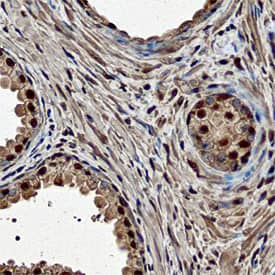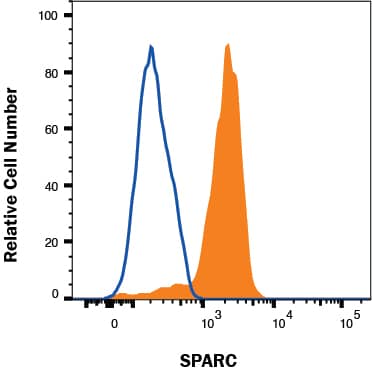Human/Mouse ELF3 Antibody Summary
Customers also Viewed
Applications
Please Note: Optimal dilutions should be determined by each laboratory for each application. General Protocols are available in the Technical Information section on our website.
Scientific Data
 View Larger
View Larger
ELF3 in A431 Human Cell Line. ELF3 was detected in immersion fixed A431 human epithelial carcinoma cell line using 10 µg/mL Human/Mouse ELF3 Antigen Affinity-purified Polyclonal Antibody (Catalog # AF5787) for 3 hours at room temperature. Cells were stained with the NorthernLights™ 557-conjugated Anti-Goat IgG Secondary Antibody (red; Catalog # NL001) and counterstained with DAPI (blue). View our protocol for Fluorescent ICC Staining of Cells on Coverslips.
 View Larger
View Larger
ELF3 in Human Liver. ELF3 was detected in immersion fixed paraffin-embedded sections of human liver using Human/Mouse ELF3 Antigen Affinity-purified Polyclonal Antibody (Catalog # AF5787) at 3 µg/mL overnight at 4 °C. Before incubation with the primary antibody tissue was subjected to heat-induced epitope retrieval using Antigen Retrieval Reagent-Basic (Catalog # CTS013). Tissue was stained using the Anti-Goat HRP-DAB Cell & Tissue Staining Kit (brown; Catalog # CTS008) and counterstained with hematoxylin (blue). View our protocol for Chromogenic IHC Staining of Paraffin-embedded Tissue Sections.
 View Larger
View Larger
Detection of Human/Mouse ELF3 by Western Blot. Western blot shows lysates of PC-3 human prostate cancer cell line, A549 human lung carcinoma cell line, and NIH-3T3 mouse embryonic fibroblast cell line. PVDF membrane was probed with 1 µg/mL of Human/Mouse ELF3 Antigen Affinity-purified Polyclonal Antibody (Catalog # AF5787) followed by HRP-conjugated Anti-Goat IgG Secondary Antibody (Catalog # HAF109). A specific band was detected for ELF3 at approximately 42 kDa (as indicated). This experiment was conducted under reducing conditions and using Immunoblot Buffer Group 1.
 View Larger
View Larger
Detection of Human ELF3/ESE-1 by Western Blot Inhibition of the SE-associated key targets attenuated LUAD malignant progression via the suppression of master TFs in CRC model.A–C Perturbation of SE associated key targets, including BRD4, EP300, and CDK7, by small-molecule inhibitors reduced the expression of master TFs significantly at protein levels. D Expressions of master TFs in LUAD cell line PC-9 treated with SE associated targets inhibitors in mRNA level were analyzed by real-time PCR. E Inhibition of invasive and migrate activity by perturbation of SE associated key targets via small molecular inhibitions. PC-9 cells were cultured with indicated small molecular inhibitions and subjected to invasion and migration assays (see “Materials and methods”). Invaded and migrated cells were stained with crystal violet and counted. Representative photographs were shown. F, G Histograms represent the number of invasion or migration cells. H In PC-9 cell lines, alterations of ELF3, EHF, and TGIF1 at protein levels while JQ1 treated for 100 nM 48 h together with or without transfected with overexpression plasmids. GAPDH and beta -actin were used as internal control, the lower panels showed the gray scale ratio of protein (ELF3) to GAPDH and protein (EHF and TGIF1) to beta -actin. *p < 0.05; **p < 0.01; ***p < 0.001. Image collected and cropped by CiteAb from the following publication (https://pubmed.ncbi.nlm.nih.gov/33070167), licensed under a CC-BY license. Not internally tested by R&D Systems.
 View Larger
View Larger
Detection of Human ELF3/ESE-1 by Western Blot Inhibition of the SE-associated key targets attenuated LUAD malignant progression via the suppression of master TFs in CRC model.A–C Perturbation of SE associated key targets, including BRD4, EP300, and CDK7, by small-molecule inhibitors reduced the expression of master TFs significantly at protein levels. D Expressions of master TFs in LUAD cell line PC-9 treated with SE associated targets inhibitors in mRNA level were analyzed by real-time PCR. E Inhibition of invasive and migrate activity by perturbation of SE associated key targets via small molecular inhibitions. PC-9 cells were cultured with indicated small molecular inhibitions and subjected to invasion and migration assays (see “Materials and methods”). Invaded and migrated cells were stained with crystal violet and counted. Representative photographs were shown. F, G Histograms represent the number of invasion or migration cells. H In PC-9 cell lines, alterations of ELF3, EHF, and TGIF1 at protein levels while JQ1 treated for 100 nM 48 h together with or without transfected with overexpression plasmids. GAPDH and beta -actin were used as internal control, the lower panels showed the gray scale ratio of protein (ELF3) to GAPDH and protein (EHF and TGIF1) to beta -actin. *p < 0.05; **p < 0.01; ***p < 0.001. Image collected and cropped by CiteAb from the following publication (https://pubmed.ncbi.nlm.nih.gov/33070167), licensed under a CC-BY license. Not internally tested by R&D Systems.
 View Larger
View Larger
Detection of Human ELF3/ESE-1 by Western Blot The regulatory interaction network in CRC model of LUAD-SE-associated TFs is interdependent.A–C, J Expressions of all master TFs in the knockdown of any master TF and validating the efficiency of siRNA targeting to master TFs by both real-time PCR and western blot. D–I Western blot and real-time PCR demonstrating that siRNA co-transfected with pcDNA3.1 could decrease the master TF expression significantly in both protein and mRNA level. This phenomenon could be partly reversed by either of another two master TFs, also could be reversed almost entirely in the combination of another two master TFs. K–M Data are shown as fold enrichments of master TFs promotor sub-regions in each antibody immunoprecipitate, ELF3 antibody (K), EHF antibody (L), TGIF1 antibody (M), over control IgG immunoprecipitate. GAPDH and beta -actin were used as internal control, the lower panels showed the gray scale ratio of protein (ELF3) to GAPDH and protein (EHF and TGIF1) to beta -actin. *p < 0.05; **p < 0.01; ***p < 0.001. Image collected and cropped by CiteAb from the following publication (https://pubmed.ncbi.nlm.nih.gov/33070167), licensed under a CC-BY license. Not internally tested by R&D Systems.
Preparation and Storage
- 12 months from date of receipt, -20 to -70 °C as supplied.
- 1 month, 2 to 8 °C under sterile conditions after reconstitution.
- 6 months, -20 to -70 °C under sterile conditions after reconstitution.
Background: ELF3
ELF3 (E74‑Like Factor 3; also ESE‑1, ESX, ERT and JEN) is a 41‑43 kDa member of the ETS family of proteins. During uncomplicated (non‑inflammatory) periods of cell differentiation, ELF3 is expressed exclusively by epithelial cells, repressing genes needed during early differentiation, and promoting genes needed for full differentiation. Under conditions of inflammation, cells such as monocytes, endothelial cells and chrondrocytes will express ELF3 and produce molecules such as Ang1 and COX2. Human ELF3 is 371 amino acids (aa) in length. It contains one PNT/pointed dimerization domain (aa 46‑132), a protein stabilizing PEST sequence (aa 210‑225), an A/T Hook region that binds to AT‑rich DNA sequences (aa 236‑252), and an ETS DNA binding domain (aa 273‑355). ELF3 interacts with CREBBP, EP300, KU70 and KU86. There is one splice variant that shows a deletion of aa 174‑200. Over aa 1‑173, human ELF3 shares 87% aa identity with mouse ELF3.
Product Datasheets
FAQs
No product specific FAQs exist for this product, however you may
View all Antibody FAQsIsotype Controls
Reconstitution Buffers
Secondary Antibodies
Reviews for Human/Mouse ELF3 Antibody
There are currently no reviews for this product. Be the first to review Human/Mouse ELF3 Antibody and earn rewards!
Have you used Human/Mouse ELF3 Antibody?
Submit a review and receive an Amazon gift card.
$25/€18/£15/$25CAN/¥75 Yuan/¥2500 Yen for a review with an image
$10/€7/£6/$10 CAD/¥70 Yuan/¥1110 Yen for a review without an image











